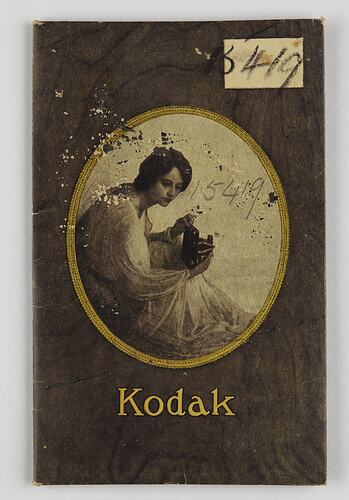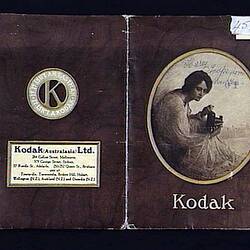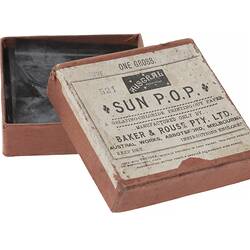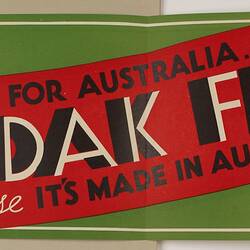Summary
Kodak photograph and negative holder featuring image of a woman holding a fold out camera on the front.
Part of the Kodak collection of products, promotional materials and working life artefacts from the Kodak factories in Melbourne. This collection dates from the late 19th century to the early 21st century and was acquired in 2005 when the Kodak Australasia Pty Ltd factory in Coburg closed down.
Physical Description
Small brown, yellow and buff coloured folder, adhered around edges, for photograph prints and negatives. Front features oval framed photographic print/etching of woman with camera.
Significance
These paper envelopes provide rich historical insight into a variety of areas.
Firstly, they tell a story about amateur/domestic photographic practice in Australia in the early - mid 20th Century. They are a link between photographer and photograph, and highlight the reality of being a photographer at this time. Photography became a specialist and divided process in the 1890s, with the local chemist or a specialist photographic supplier [more likely in large cities], providing the service of chemical developing and printing of photographs. Whilst some photographers were committed to their own developing and printing, from this time on most relied on others to do this specialist work for them. This commercial photographic processing service has continued to the present day, although new media such as digital imaging now offer other opportunities for amateur photographers - for example digital cameras and personal computers have given photographers their own digital darkroom.
These envelopes also remind us that photography in the early - mid 20th Century was built around negative film and paper photographic prints. Today, in comparison, digital photography has its own unique accessories and paraphernalia, creating a new era of photographic material culture.
Further, these simple paper envelopes suggest insight into the commercial photographic business, and small business. The pencil markings on the packets reveal the presence of workers in these businesses, highlighting a more manual work method.
The envelopes also highlight graphic design and packaging of the early to mid 20th Century, and alert us to marketing themes, such as the dominant use of women to sell cameras and film in the domestic market.
More Information
-
Collection Names
-
Collecting Areas
-
Acquisition Information
Donation from Mr Alan Schoknecht, Jan 2004
-
Distributor
-
Organisation Named
-
Inscriptions
Printed, front: "Kodak" Printed, reverse: "IF IT ISN'T AN EASTMAN / IT ISN'T A KODAK / Kodak (Australasia) Ltd. / 284 Collins Street, Melbourne ..." and further associated text.
-
Classification
-
Category
-
Discipline
-
Type of item
-
Overall Dimensions
75 mm (Width), 120 mm (Height)
-
References
Photograph and negative holders are collectables - see the Kodak Girl Film Wallets collection- [Link 1] Further research to be conducted in these fascinating items
-
Keywords
Photography, Photographsic Accessories, Negatives, Photographs



